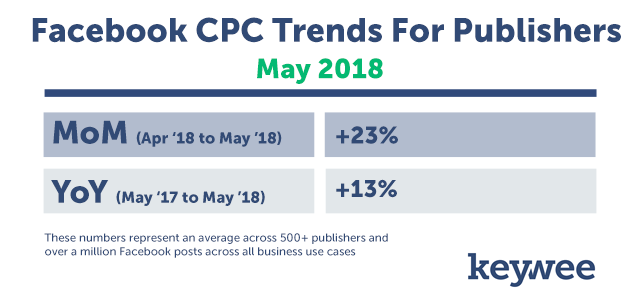At the beginning of the year, amid many questions about Facebook changes and the state of content distribution, we launched The Keywee Facebook CPC Tracker, a monthly update on Facebook CPCs based on analysis of data from over 500 publishers, to try to answer some of these questions.
We release new data every month, along with relevant insights on content distribution. You can sign up for monthly updates straight to your inbox here, and read past months’ updates here.
May Data: Publishers Continue to Spend Wisely
In May, we saw increases in CPCs both month over month and year over year. This should not come as a huge shock: prices are generally at their lowest at the beginning of a quarter, so the second and third months of the quarter are prone to month over month increases. Given that April had especially low CPCs, the larger-than-usual monthly increase seems to be evening out an overall pricing trend.
We’ve also seen year over year increases (to varying degrees) in CPCs every month this year. This is to be expected as Facebook’s ad platform becomes more popular, and inventory does not grow at the same rate. In Facebook’s Q1 earnings call, they shared that ad revenue has gone up by 50%, but Active Users only increased by 13%. It seems in order to keep up with the increasing demand, prices are increasing.
That all being said, price fluctuations were not constant across the publishing industry. Every “use case” (or type of campaign) saw a CPC increase, but some types saw more favorable pricing than others.
Audience Development
Audience development, arguably the most common type of campaign on Facebook, is also generally the most stable. Perhaps because of the predictability of this type of spend, we generally don’t see huge fluctuations in CPCs from month to month.
This month was no different. For general audience development campaigns, we saw the low double-digit increases in CPC that one would expect in the second month of a quarter, partnered with healthy spend increases. This implies that publishers are continuing to see success building a core audience on Facebook, by driving qualified users to their best content.
Profitable Audience Development
Profitable audience development is the practice of bringing audiences to your website to drive same-session revenue. So long as you spend less to acquire the audience than you make in that session, you can continue to spend profitably.
For publishers running Facebook posts in order to do this, May was not a great month. CPCs were 25% higher than they were in April, and unfortunately, RPMs (revenue per thousand users) were not increasing at the same rate. Therefore, it was hard for publishers to scale their spend profitably this May; we actually saw a spend decrease month over month from this cohort of publishers.
While CPCs are likely to continue to climb in June due to quarterly patterns, we expect RPMs to increase as well, making it once again possible to scale Facebook spend.
Email Subscriptions
Luckily, May was not all bad news. Publishers spending on acquiring new email subscribers on Facebook saw a price increase of just 1% month over month, despite healthy increases in spending on this use case.
Email continues to be a lucrative business for publishers, so it makes sense that smart publishers are turning to paid acquisition channels like Facebook to increase their subscriber base. The Kiplinger team told Digiday reporter Max Willens that they’ve used Facebook to acquire more than 30,000 new email subscribers at a 3X ROI in the past couple of months alone.
Keywee customers (including Kiplinger) continue to efficiently scale their spend on email acquisition thanks to a new product: Content-to-Capture. Content-to-Capture utilizes a publisher’s content to engage and acquire high quality email subscribers at a lower cost-per-acquisition (CPA) than direct response ads or on-site email capture. You can learn more about the process here.
Paid Subscriptions
Of course, new emails are not the only thing publishers are looking to acquire on Facebook. As publishers look to diversify their revenue, paid subscribers are the new holy grail. And we see this in the data: spend on Facebook to drive new paid subscriptions has more than doubled year over year, despite the steepest CPC increases this month. But while CPCs are steadily increasing, for this type of campaign, the real metric to look at here is Cost Per Acquisition (CPA).
Facebook is a great tool for driving readers down a subscription funnel. By targeting the right readers with the right content, you can form a habit that includes your brand. This requires targeting the same users again and again, so naturally, the CPCs will be higher than your average content post. This method is an extremely effective way to gently push users toward subscriptions, especially when paired with external factors like a paywall.
Of course this method takes a bit longer than direct response, but the results are well worth it. Using this method, we see much lower CPAs (vs. direct response ads) that bring in more engaged users, and best of all – the process is much more scalable.
To sign up for future CPC updates, fill out the form below:
About Keywee
At Keywee, we make stories relevant and powerful for the world’s best storytellers — like The New York Times, The BBC, National Geographic, Forbes, and Red Bull.
Today, people aren’t coming to websites to search for content — stories find their audiences in feeds and apps. The upshot? Distribution is now the key for effective storytelling. Keywee’s platform unlocks audience insights using AI and data science, and infuses them into every step of the storytelling process: from topic selection, to story creation, to distribution and optimization. Keywee is backed by leading investors such as Google’s Eric Schmidt and The New York Times, and has been a fast-growing, profitable startup since its inception. To learn more, request a demo here.


